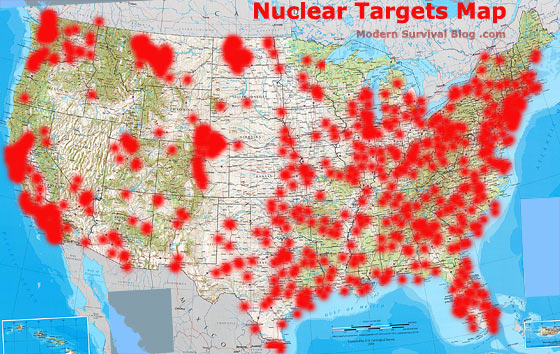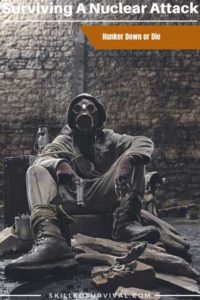
Because there’s nothing that frightens me more than a nuclear attack. I’ve spent hours thinking about how to survive a nuclear war. Why? Because not only are they the most destructive device known to man. But surviving one might be worse than death!
Barely surviving the initial blast means days or weeks of acute radiation sickness.
TOPICS IN THIS GUIDE… ↓(click to jump)
- Bad News Out Of The Way
- Factors You CAN’T Control
- Basic Nuclear Fallout Theory
- Air Bursts vs. Ground Bursts
- Nuclear Contaminated Water
- The Scary Truth About Fallout
- Potassium Iodine Pills
- Decontamination Process
- How To Survive Nuclear
- One Thing You Can Control
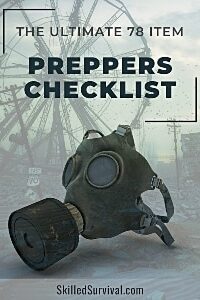
Want a free 78 item bug out bag checklist?
Enter your email below to instantly download this Complete Checklist PDF. No purchase necessary. 👇 👇Let’s Get The Bad News Out Of The Way
In the old days of the Cold War, the US Air Force had an unwritten but precise procedure on How To Survive A Nuclear Attack.
Stick your head between your legs and kiss your ass goodbye!
A friend of mine told me his old Air Force Tech Sergeant’s plan –
“I’m gonna break out my lawn chair and 50,000 SPF sunscreen and watch the fireworks.”
To be honest, if you are in the blast zone or anywhere close – you’ve screwed six ways to Sunday.
↓ Under Water Nuclear Test (It Went Bad)
This might not be the worst news because you’ll be vaporized within milliseconds of the blast. Your suffering’s over before it even begins. You won’t feel a thing; good for you.
On the other hand, if you live just outside the shockwave range – you’re in for a world of pain and anguish. You’re far enough away to survive the initial blast, but you’re still way too close.
In this range, if you try going outside to travel, you’ll be signing your own death certificate.
The fallout will blanket your area even if you escape the initial radiation. Causing acute radiation poisoning, cellular decay, and, frankly, a horrific death.
↓ What Does Radiation Poisoning Do To Your Body?
If you’re even further away but downwind of the blast, sorry, you’re still screwed for the same reason. Nuclear fallout is a bitch.
I didn’t want to start off this article by sugarcoating things. A nuclear war or a nuclear attack of any sort is very bad news. Thousands, if not millions, dead or sick, and the world changed for the worst for a very long time.
↓ I’ve Studied Nuclear War For 35 Years – You Should Be Worried
But it’s not all hopeless. If you take the potential of a nuclear attack seriously, there are things you can do to stack the deck in your favor. But before we discuss the things you CAN control, let’s talk about the things you CAN’T.
The Nuclear Factors You Can’t Control
Several key factors will determine your ultimate fate – none of which you control:
- The number of nukes used
- The size of the nukes
- The prevailing winds
- Airburst or ground burst attacks (ground burst stirs up more fall out)
- Distance from Ground Zero (because there’s no way to know exactly where ground zero will be)
- Rain and weather
NONE of these factors are in your control. The number and size of the nukes will be determined by those who choose to attack and counter-attack. The prevailing winds at the time of the attack will make a major difference in who gets the fallout.
As we’ll discuss shortly, air bursts and ground burst detonations also make a huge difference.
We can make an educated guess on where the most likely ground zeros will be. But it’s still just a guess. And we also don’t know if the nuke will be a direct hit of the target or a complete miss.
Lastly, you can’t control the environmental factors after the blast. The weather after the blasts will determine how quickly the surrounding areas become “safe” again.
Now just because we can’t control these factors doesn’t mean we should be ignorant about them. So let’s take a few minutes to understand the basic nuclear fallout theory.
↓ Can You Survive Nuclear Fallout?

Want a free 78 item preppers checklist?
Enter your email below to instantly download this Complete Checklist PDF. No purchase necessary. 👇 👇Basic Nuclear Fallout Theory
Immediately after a nuclear explosion, there’s a massive pulse of radioactive energy. If you’re outside and get hit by this pulse, it’s like getting hit with trillions of microscopic bullets. Tiny bullets pass right through you, destroying all your body’s cells.
The human response to this radiation is subject to great scientific uncertainty and intense controversy. However, even small doses of radiation can do significant harm. So your chances of suffering from acute radiation syndrome are much higher. But, this initial radiation pulse is NOT what contaminates everything in the environment.
If you hit a concrete block with a lethal dose of gamma rays, the block does not itself become radioactive. Radioactive contamination comes from:
- The fissionable material (i.e., Uranium) that was not consumed in the explosion and
- Radioactive isotopes are produced during the nuclear reaction.
This material is blasted into billions of microscopic particles. And they are also heated to millions of degrees. They become radioactive plasma which will infiltrate and permeate everything it touches.
For example, the soil near the nuclear explosion becomes dangerous. Why? Because it becomes infused with radioactive by-products created by the blast. The blast particles mix with all the dust and debris and become a cloud called fallout.
This fallout cloud eventually settles like a blanket back to the earth. Onto your house,
So, if you’re one of the “lucky ones” inside during the initial pulse, you now get to worry about the fallout. But the amount of fallout a nuclear explosion creates depends on its type – air burst or ground burst.
↓ This Is How A Nuclear Bomb Works
Air Bursts Vs. Ground Bursts
Air bursts do more structural damage, but ground bursts raise more fallout – and kill more people. Standard nuclear tactics call for ground bursts. As a frame of reference, Nagasaki and Hiroshima were both air bursts. Most people don’t realize this.
Most people believe these were ground burst detonations, but they were not. They exploded in the air before they reached contact with the ground.
I won’t get into all the physics behind the air burst vs. ground bursts here.
The bottom line is this: If the bomb reaches the ground and explodes, it becomes a massive crater. A massive amount of dirt and soil gets dislodged and thrown into the air. These soil particles mix with the radioactive ones and become fallout. But, in an airburst, the radioactive pulse reaches further but doesn’t create much of a crater.
No crater means less disrupted soil which produces less radioactive fallout.

Want a free 78 item preppers checklist?
Enter your email below to instantly download this Complete Checklist PDF. No purchase necessary. 👇 👇Nuclear Contaminated Water
One of the most frequent questions I get from readers is – how to treat nuclear-contaminated water. The reasoning behind this question is understandable. If a nuclear blast happens near you – is there a safe way to drink water from the environment?
They realize that this would be a worst-case scenario – the ultimate catch-22. To die of dehydration or to consume deadly radioactive particles…
Sadly, most nearby natural water sources will become contaminated by nuclear fallout. The only exceptions are water that’s protected underground (such as natural springs). Sure, while the water is underground, it may be safe. But as it reaches the surface, it becomes contaminated as well.
I know of no way to ensure a natural water source is 100% safe if it’s been contaminated by radioactive fallout. There’s no tablet you can add to purify the radiation out of it. By the way – I 100% guarantee the water won’t have any dangerous bacteria in it.
The radioactive contamination will kill all organisms that are present in the water. But that’s of little comfort.
You can only try to run the water through charcoal or very fine water filters. The hope is to separate out the radioactive particulates – no guarantees, though. Your best bet is only to drink stored water or bottled water.
That’s one excellent reason to stockpile water. It’s wise to avoid the experience of swallowing fallout-laced H2O. Also, if it’s not obvious, boiling water will not remove nuclear contaminates either.
What About Rainwater?
Rain clouds may become contaminated as well. If you’re using a roof or tarp as a rainwater collection device, they’ll collect fallout too.
Hence, contaminate the rain droplets with the fallout. So even pure, safe rain can become dangerous to consume after a nuclear explosion.
The Scary Truth About Nuclear Fallout
The fact is, even if the radiation levels are too low to kill you right away, the environment will be dangerous. It will contain low concentrations of contamination for a very long time. There will be many cases of leukemia and cancer for survivors of the area.
How Bad Can The Environment Get?
I used to laugh at one item in the USAF Survival Manual. It said,
“after a nuclear exchange, do not eat wild game meat within 3/8” of the bone.”
Why? Because the radioactive isotopes released into the environment will concentrate on the animal’s bone marrow. So, the meat closest to the bone has the most radiation. It assumes you’ll be consuming radiation, try not to eat the super-concentrated stuff. Great. Thanks for the advice.
It goes to show you just how bad it can get…
↓ How To Survive Nuclear Fall Out
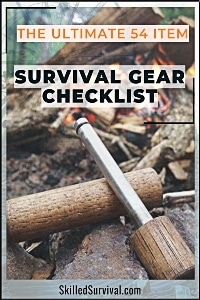
Want a free 54 item survival gear checklist?
Enter your email below to instantly download this Complete Checklist PDF. No purchase necessary. 👇 👇Potassium Iodide (KI) Pills
Maybe you’ve already heard of stocking up on potassium iodide pills. How they can help prevent getting sick from nuclear radiation. Hey, it is officially recommended by the CDC – but the truth is, it’s a very limited protection measure.
Potassium Iodide pills help protect your thyroid gland from absorbing radiation. Yes, your thyroid gland – none of the other thousands of organs in your body. But to be fair, the thyroid gland readily absorbs radioactive particles when present.
It’s one of the first organs in the body to become cancerous after radiation exposure.

They help to protect your thyroid gland – no more, no less. Better than nothing, I suppose but not “the perfect answer” either.
↓ Nuclear Disasters: Show You Get Iodide Now?
Decontamination
If you believe you’ve been exposed to radioactive particles, the first step is to get out of the exposed area. Get inside fast.
The next thing you want to do is decontaminate yourself. Your clothes and skin are likely carrying minuscule radioactive particles around with you. Potentially contaminating other people – such as your loved ones.
The good news is decontamination is straightforward. Scrub. When exposed for a short duration, it’s possible you sustained only external contamination (not internal). And the best way to make sure it stays that way is to:
First, remove all your clothes (shirts, shoes, underwear – everything). Next, place them all in secure plastic bags. Removing these items will eliminate roughly 90% of external contamination.
Next, shower with soap and water. Scrub hard to remove any possible radiation from your hair and skin. Scrubbing helps with the remaining 10% of external contamination. But don’t scrub so hard you bleed.
Scrubbing in a shower also lowers the risk of breathing and ingesting harmful radiation particles. The water droplets knock any radiated skin particles down the drain and not into your lungs. That’s it.
When it comes to being exposed to radiation, you should always,
- Get the hell out of there ASAP, and
- Decontaminate yourself.

Want a free 78 item preppers checklist?
Enter your email below to instantly download this Complete Checklist PDF. No purchase necessary. 👇 👇How To Survive A Nuclear Explosion
First, pray you’re not outside to see the nuclear blast. If you’re anywhere near the blast zone, you’re toast. The further away, the better, of course. But it’s best to be inside with several building layers between you and the blast.
Get Inside, Stay Inside
If you were outside during the blast but far enough away to survive, again, get inside as fast as possible. And if you were inside, don’t go venturing outside.
People who do have a high probability of becoming a literal member of The Walking Dead (someone who’ll be dead soon but doesn’t know it yet)…
Stay inside with doors and windows closed until radiation in the environment drops. It will take a while (we’re talking at least weeks or even months for major fallout). Holing up underground is the best approach – whether upwind or downwind – at least for a long while.
Hole up in a basement, if possible, or even an underground bunker. Preferably one with your stockpiled food and water. And wait. Wait for the fallout to settle and the weather to dilute it somewhat before you go trouncing through it.
Ok, and your natural desire to get further away may be the worst (and last) decision you ever make. Wait inside as if your life depends on it because it will. Try to plan on hunkering down inside for at least a month for a single blast (or longer for an all-out nuclear war).
It will be mind-numbingly boring. Plan for it. You need lots of puzzles, board games, projects, movies, survival books, etc. Anything to keep you from going insane or outside. Both may be the same after a few weeks of being cooped up.
Get A Gas Mask
Yes, a quality gas mask is better than nothing. These allow you to prevent breathing radioactive contaminants if you must venture outside. We recommend any of the gas masks and filters from MIRA Safety.
↓ MIRA Safety | CM-6M & CM-7M Gas Masks
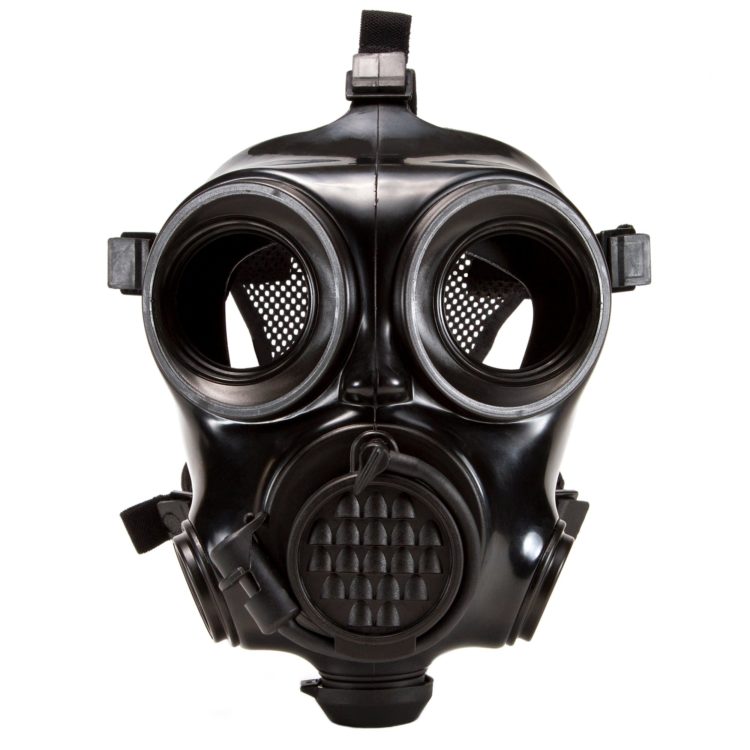
It’s best to stay indoors if possible.
Another thing to consider is where you are in a multiple-target situation. You may be upwind and fifty miles out from a nuclear blast to the east – that’s good. But you might be one hundred and fifty miles downwind of the fallout from a nuke in the west.
Let’s imagine a single terrorist attack (say Denver). Luckily, you live west of downtown (and outside the blast zone and upwind of the fallout).
Now, you might be thinking – ya know, another fifty miles west might be a good idea right now. And if you’re confident no other nukes will be lighting off (east or west), you could make a run for it to the West. But what if the wind decides to shift on you? Your local weatherman on the TV won’t be there to give you a heads-up.
Get A Hand Crank Radio
Ideally, you’ll have a quality hand-crank radio available to listen for updates from the authorities. Why a hand-crank radio? Because the grid will be destroyed for a very long time and batteries will run out.
With hand crank radios, you can generate your own power. Just crank.
↓ How To Survive A Nuclear Attack
The One Thing You CAN Control
The bottom line is this: Nukes are extremely nasty devices. Surviving them is not easy and takes a whole lot of luck.
The best thing you can do today to prepare for a nuclear attack is to relocate strategically to a remote area. To move to an area that’s not near or downwind of a major target city.
That’s the only way I know on how to survive a nuclear attack.
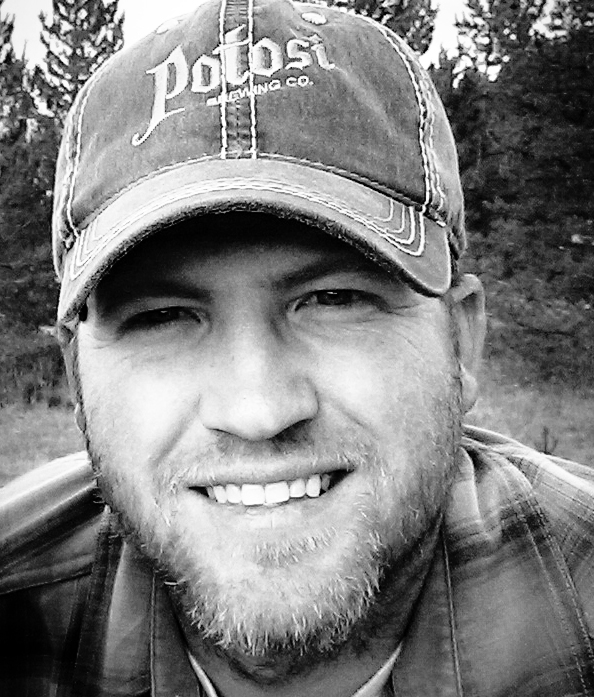
Prepare, Adapt & Overcome,
P.s. - I just found out 2 out of 3 Americans don’t feel prepared for a 3 day disaster!!!
I guess this goes to show how modern society continues to embrace ‘living a fragile life.’ What’s crazy is… it’s so easy to fix.
To make sure YOU have the basics, watch our FREE training on “10 Simple Steps To Basic Preparedness” that shows you HOW.
Nothing crazy here… this isn’t doomsday prepping... just the basics every responsible adult should have before a disaster strikes.Why You Can Trust Skilled Survival...
Go here now to review a full breakdown of:
- Who We Are
- Our Credentials
- Our Mission
- & Product Recommendations...
Here are a few highlights of our teams credentials & certifications:
- Certified Member of a Mountain Search & Rescue Organization
- Plant Emergency & Safety Leader for a Major Food Manufacturer
- Member of the 10TH Mountain Division Hut Association
- Certifications: Avalanche 1, WFR, CPR
- Official Gear Tester for Numerous Outdoor Gear Companies
- Countless Multiday Backpacking trips into Remote Wilderness
- Bachelor's Degree In Mechanical Engineering
- Bachelor's Degree In Civil Engineering
- Bachelor's Degree In Biomedical Engineering
"It takes 20 years to build a reputation and five minutes to ruin it." - Warren Buffett
We're fully aware that trust is NOT something you GET but is EARNED.
And we'll continue to earn YOUR trust through our forthright and honest approach with each new Blog Post, Guide & Product we create...
P.s - I just took this FREE 60-second 'Readiness Score Quiz'👇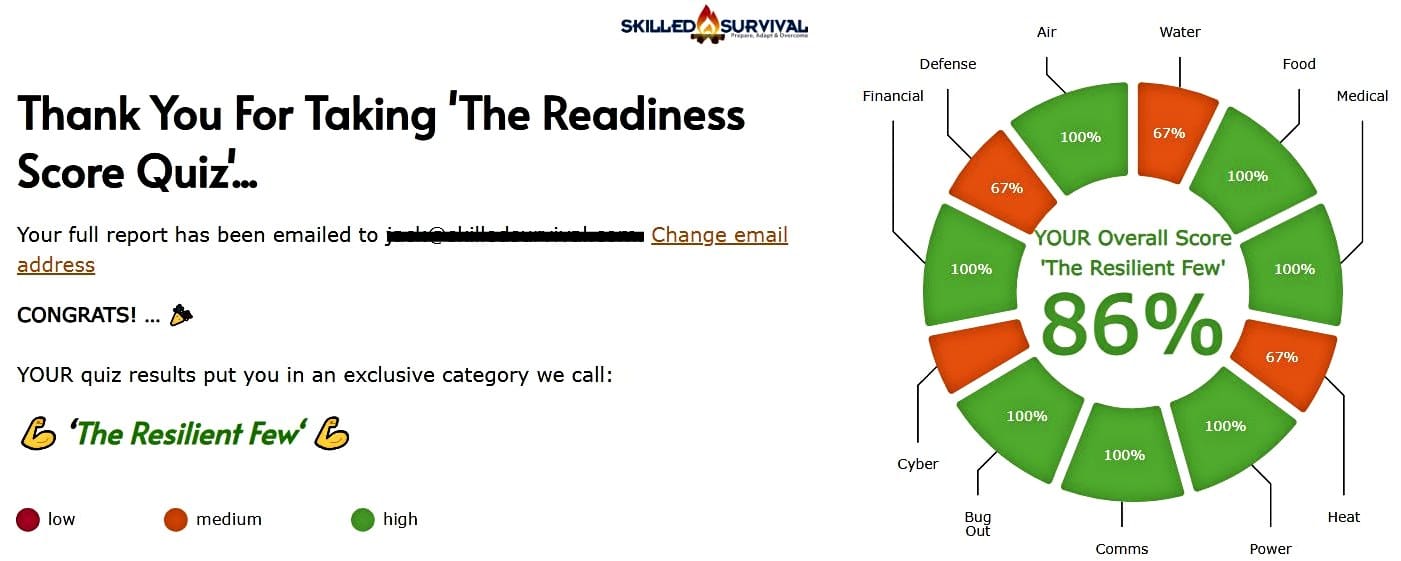
AND... I've still got a few gaps in my preps...🤔 But at least, I'm not part of 'The Fragile Masses'. 👍 Find out where YOU stand by answering a few questions...
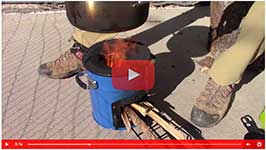
Recommended Reading
Long Term Fuel Storage For Survival Emergencies
Long term fuel storage is crucial in emergencies, but fuels must be stored properly especially long term gasoline storage.
How To Store Seeds For Wise Prepping & Survival
When seed saving and seed storage, you must do it right. Learn how to store seeds so they'll thrive the next planting season.
Common Everyday Carry Mistakes YOU Must Avoid At All Costs
The only person qualified to build YOUR Best Everyday Carry (EDC) is YOU. To do it right, you must avoid these common mistakes and pitfalls.
Strategic Relocation: How To Find A Safe Pace To Live
Use strategic relocation to find a safe, defendable location to call home. Your choice of location WILL determine your survival fate.
Nuclear Fallout Map: Would I Survive A Nuclear Bomb?
Have you seen this nuclear fallout map? Or run a nuclear simulation to see the damage a nuke would do to your city? If not, check this out.
Homestead Survival: How To Master Plan Your Safe Haven
Use this simple 6 homestead survival plan to successfully survive (and thrive) even if the world falls into chaos...
